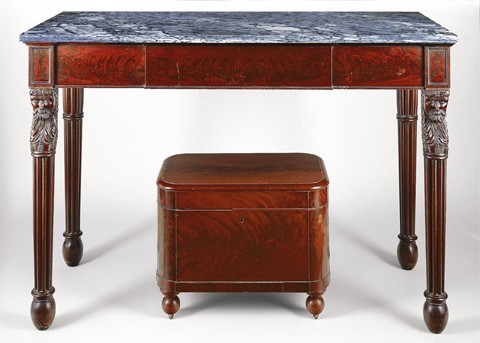
Pier table and liquor case by Edward Priestley, Baltimore, Maryland, 1827. Pier table: mahogany with yellow poplar and white pine; marble. H. 42 3/4", W. 62", D. 26 3/4". Liquor case: mahogany with yellow poplar, white pine, and mahogany. H. 20 1/4", W. 26 1/2", D. 17 1/2". (Private collection, photo, Gavin Ashworth.) Although the smooth, rounded surfaces of the liquor case contrast with the rectilinear form and carved and reeded decoration on the pier table, similar incongruities are prevalent in design book illustrations for these forms. See Thomas Hope, Household Furniture and Interior Decoration (1807), pls. 13, 15, 22.

Daniel Bowley, Esq., Baltimore in 1752, From a Sketch Made by John Moale, Esq., Baltimore, Maryland, 1817. Aquatint. Dimensions not recorded. (Courtesy, Maryland Historical Society.)
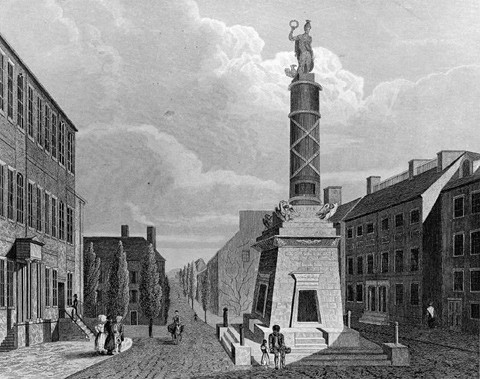
W. Goodhue, Jr., Battle Monument, Baltimore, issued by Archer & Boilly, New York, c. 1831. (Courtesy, Winterthur Museum.)
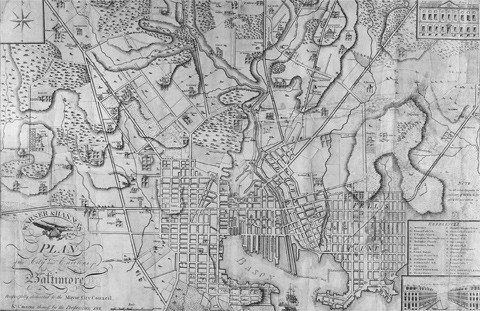
Warner & Hanna’s Plan of the City and Environs of Baltimore, engraved by Francis Shallus, Philadelphia, 1801. Dimensions not recorded. (Courtesy, Winterthur Museum.) In 1801, Baltimore and its environs included Baltimore-Town, Fell’s Point, and Jones Town. Warehouses were located close to the water, which was the city’s economic nucleus, and commercial establishments were situated to the north and concentrated around Baltimore (or Market) Street.
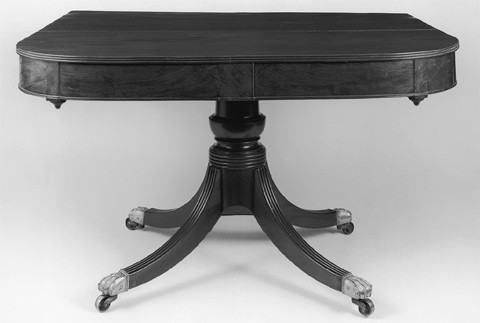
End of a three-part dining table attributed to Edward Priestley, Baltimore, Maryland, 1810–1815. Mahogany with yellow poplar and oak. H. 28 3/4", W. 164" (all three sections), D. 56 3/4". (Private collection; photo, Gavin Ashworth.)

Card table attributed to Edward Priestley, Baltimore, Maryland, 1810–1815. Mahogany with yellow poplar, white pine, oak, and beech. H. 28 3/4", W. 36", D. 17 1/2". (Private collection; photo, Gavin Ashworth.)

Detail of the top and pillar of the card table illustrated in fig. 6. (Photo, Gavin Ashworth.) The top has wedge-shaped mahogany veneers that eminate from a half-round mahogany panel.
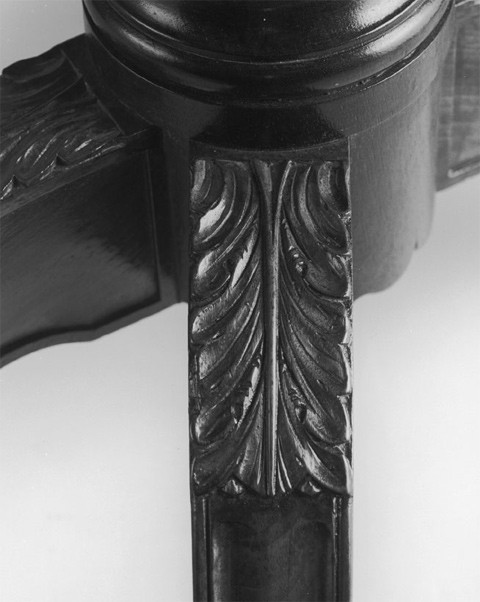
Detail of the leg molding and carving on the card table illustrated in fig. 6. (Photo, Gavin Ashworth.)

Sofa attributed to Edward Priestley, Baltimore, Maryland, 1810–1815. Mahogany with yellow poplar. H. 35", W. 96", D. 24 1/2".
(Private collection; photo, Gavin Ashworth.)

Detail of the seat frame construction of the sofa illustrated in fig. 9. (Photo, Gavin Ashworth.)
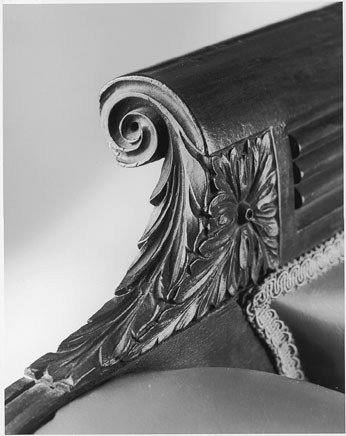
Detail of the carving on the crest rail of the sofa illustrated in fig. 9. (Photo, Gavin Ashworth.)
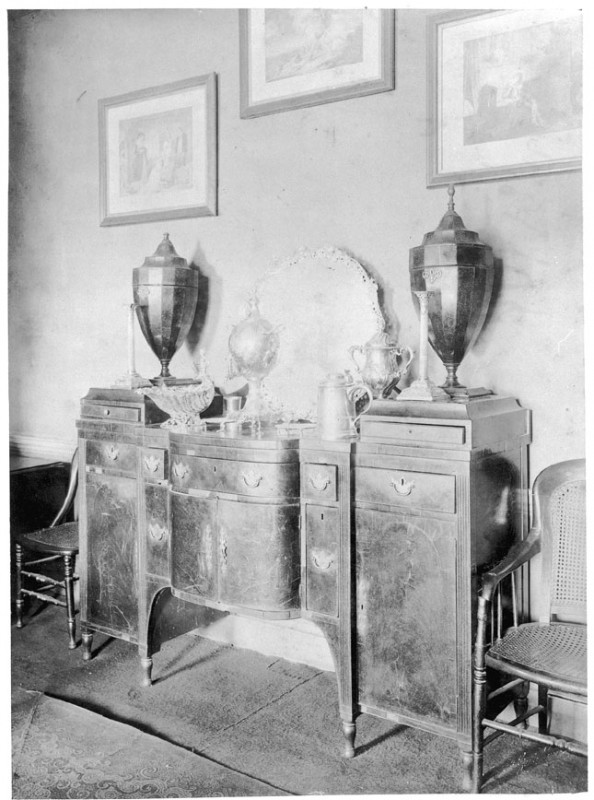
Circa 1900 photograph showing a sideboard attributed to Edward Priestley, Baltimore, Maryland, 1810–1815. (Private collection; photo,Gavin Ashworth.)
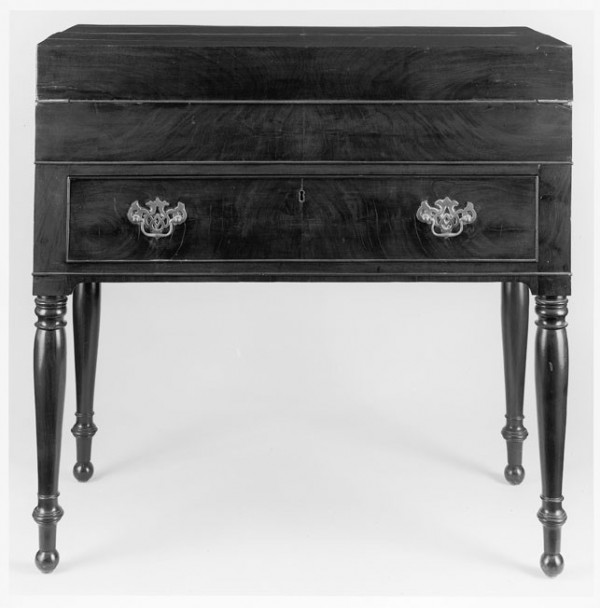
Writing desk attributed to Edward Priestley, Baltimore, Maryland, 1810–1815. Mahogany with yellow poplar and white pine. H. 36", W. 36", D. 17 3/4". (Private collection; photo, Gavin Ashworth.)

Detail showing the attachment of the desk and table sections of the writing desk illustrated in fig. 13. (Photo, Gavin Ashworth.)

Writing desk attributed to Edward Priestley, Baltimore, Maryland, 1810–1815. Mahogany with yellow poplar and white pine. H. 37", W. 32", D. 32 1/4". (Courtesy, Baltimore Equitable Society; photo, Gavin Ashworth.)
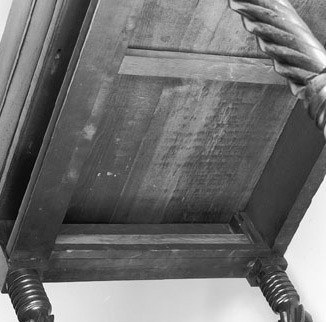
Detail showing the attachment of the desk and table sections of the writing desk illustrated in fig. 15. (Photo, Gavin Ashworth.)
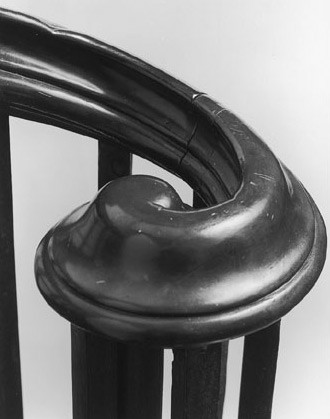
Section of handrailing by Edward Priestley, Baltimore, Maryland, 1826. (Photo, Gavin Ashworth.)
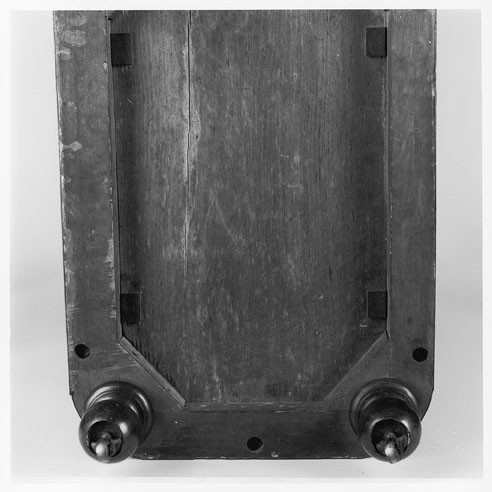
Detail of the base construction of the liquor case illustrated in fig. 1. (Photo, Gavin Ashworth.)
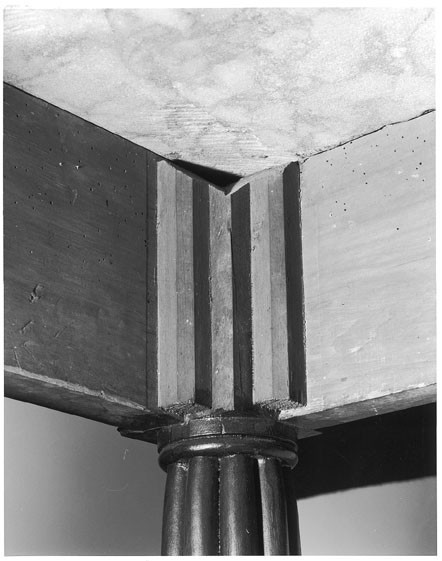
Detail of the glue blocks on the pier table illustrated in fig. 1. (Photo, Gavin Ashworth.)
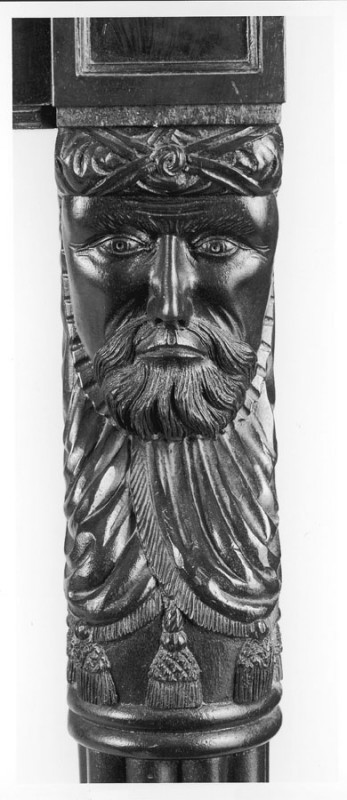
Detail of the carved mummy head on the right front leg of the pier table illustrated in fig. 1. (Photo, Gavin Ashworth.)

“Indian or Bearded Bacchus” designs illustrated on plate 57 of Thomas Hope’s Household Furniture and Interior Decoration (1807). (Courtesy, Winterthur Library, Printed Books, and Periodical Collection.)
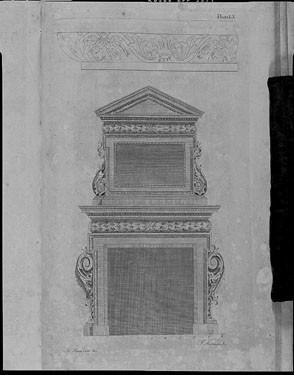
Design for a chimney piece illustrated on plate 52 of Abraham Swan’s The British Architect or, The Builder’s Treasury of Staircases (1758). (Courtesy, Winterthur Library, Printed Books, and Periodical Collection.)
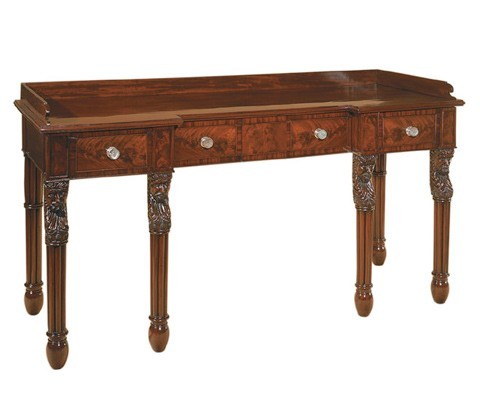
Sideboard table attributed to Edward Priestley, Baltimore, Maryland, 1825–1835. Mahogany with yellow poplar, oak, and mahogany. H. 39 3/4", W. 82 1/4", D. 27 1/2". (Private collection; courtesy, Hirschl and Adler Galleries.)

Sideboard attributed to Edward Priestley, Baltimore, Maryland, 1825–1835. Dimensions and woods not recorded. The sideboard was lot no. 107 in O. A. Kirkland’s Catalogue of the Celebrated Dr. William H. Crim Collection of Genuine Antiques (1903).
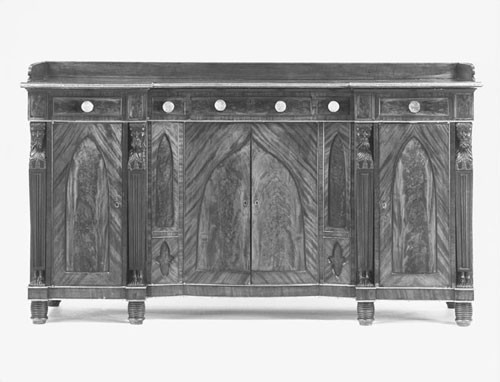
Sideboard attributed to Edward Priestley, Baltimore, Maryland, 1825–1835. Mahogany with yellow poplar, yellow pine, and mahogany. H. 46 3/4", W. 82 1/4", D. 27 1/2". (Courtesy, Baltimore Museum of Art.) The sideboard is comprised of three dovetailed cases that rest on a joined frame. The right pedestal is fitted with a round revolving bottle holder.

Detail of a mummy head on the sideboard illustrated in fig. 25.
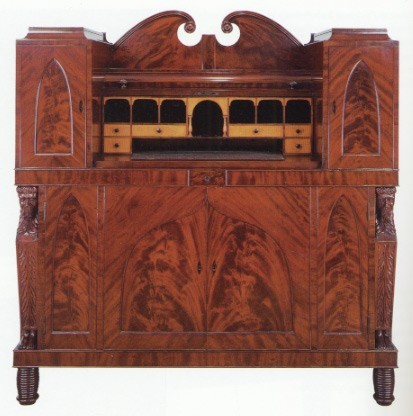
Desk attributed to Edward Priestley, Baltimore, Maryland, 1825–1835. Mahogany, satinwood, and ebony with yellow poplar, white pine, and mahogany. H. 56 3/4", W. 54", D. 22 1/4". (Courtesy, Maryland Historical Society; photo, David Prencipe.)
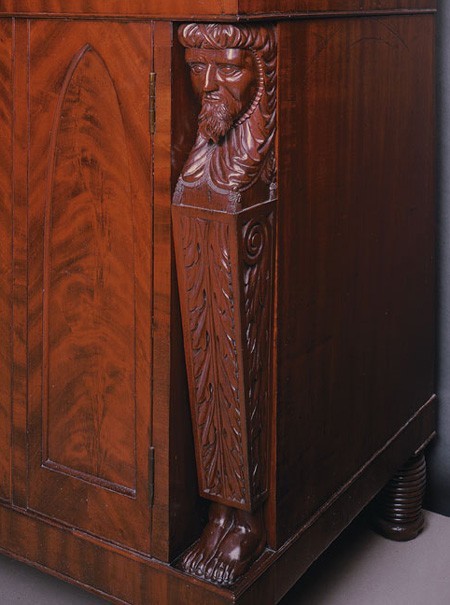
Detail of the mummy head and therm on the right side of the desk illustrated in fig. 27.
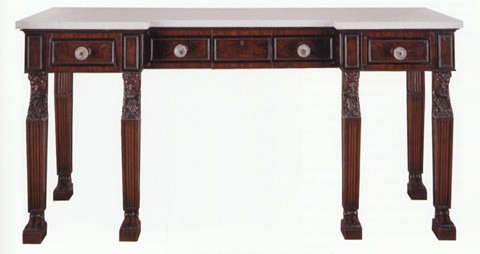
Sideboard attributed to Edward Priestley, Baltimore, Maryland, 1825–1835. Mahogany with yellow poplar and white pine; marble. H. 40", W. 82 1/4", D. 24". (Courtesy, Andalusia Foundation; photo, Gavin Ashworth.)
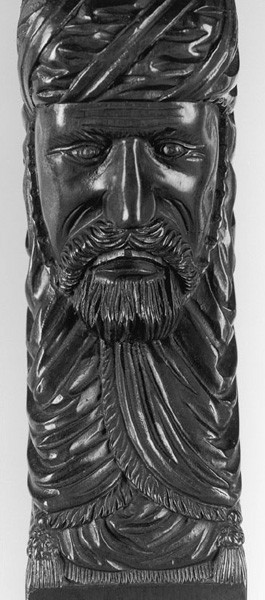
Detail of a mummy head on the sideboard illustrated in fig. 29. (Photo, Gavin Ashworth.)

Chest of drawers attributed to Edward Priestley, Baltimore, Maryland, 1825–1835. Mahogany. Secondary woods and dimensions not recorded. (Courtesy, Sotheby’s.)
